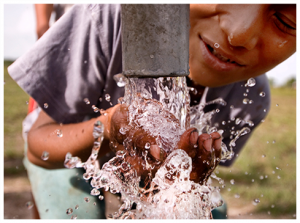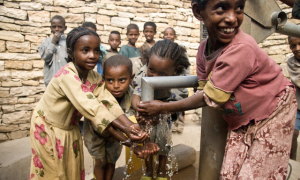Did you know water was declared a human right in 2010 by the United Nations? Yet, 884 million people are still without access to safe drinking water and, more than 2.4 billion people lack access to basic sanitation. These statistics are pretty shocking to me because despite many advances, we are  facing this problem in the 21st century. Changes in the environment and climate have impacted major sources of freshwater in many parts of the world. As the world population grows towards over seven billion, water may become even more sparse as more and more people are losing access to fresh clean water because of these changes.
facing this problem in the 21st century. Changes in the environment and climate have impacted major sources of freshwater in many parts of the world. As the world population grows towards over seven billion, water may become even more sparse as more and more people are losing access to fresh clean water because of these changes.
Water is everyone’s problem and this problem needs to be addressed. Unfortunately, this issue has not received the attention it deserves from my perspective. Some governments and organizations have recognized that this is a problem, however no concrete plan has been created or established. I believe the best way to push for action is by working together. Non-profit organizations, governments, international organizations, and the private sector can collaborate together, and effectively create change.
A real roadmap needs to be laid out on how to tackle this issue. At worldwide conferences such as Rio+20, delegates from countries recognize a problem, however when these delegates return to their own countries, often no real progress occurs. Unfortunately it is likely that the outcome document of the conference and statements regarding water and sanitation, will not create any real progress because there are no concrete goals involved. Without goals, no one will really take the first step. National, state, and local Governments, NGOS, and professionals from the private sector need to collaborate and work together to make long lasting change.
I recently went to a conference in April at Yale University. There were three non-profit organizations at the conference presenting with missions based on water and sanitation. If these organizations collaborated, they may actually achieve lasting and huge results from their combined efforts. For example, Charity Water, Water.org, and WaterAid are all organizations that focus on delivering clean water to those that do not have access. All of their mission statements are quite similar. In addition,  these organizations also stress that water impacts everything including education, health, and even rights of children and women. They fundraise to create wells in rural communities to supply them with clean water and work with local partners in their project site areas, so that the communities have a say in the projects.
these organizations also stress that water impacts everything including education, health, and even rights of children and women. They fundraise to create wells in rural communities to supply them with clean water and work with local partners in their project site areas, so that the communities have a say in the projects.
An idea for a collaborative strategy for this work would be to create an advocacy alliance to appeal to local and central governments to place more emphasis on the water crisis. They could also partner up with the private sector and international organizations such as the World Health Organization, UN Water, or Unicef to gain more support. This will form more awareness around the issue and it will also push others to take action.
Another strategy would be for the organizations to collaborate and work with governments and professionals from the private sector to create a plan to combat the overall issue. Charity Water, Water.org, and WaterAid have actual experience in working with the communities that are facing the water crisis. Therefore, they will be able to advise local or central governments on how to approach certain issues such as water access, sanitation, and working with communities
in the correct manner. The charites can use their local partners and include them as vital part of the plan especially with implementation.
By working together, these organizations will be able to push governments, and the private sector to work together to create a concrete plan. In addition, these non-profit organizations can help put the issues of water into the spotlight. I am huge fan of collaboration and working as a team. I think that collaboration can help with creating change and it can make a difference. The more support there is for change, the better possibility for change and action to actually occur. In short, stronger concrete plans, collaboration, advocacy, and awareness can really help bring about a solution to this critical issue. Collaboration is a powerful tool that every organization looking to make social change should consider because it is effective and influential at the same time. I really hope that non-profit organizations realize the potential of collaboration and use it as an advantage to create an bigger impact in critical issues such as water.


